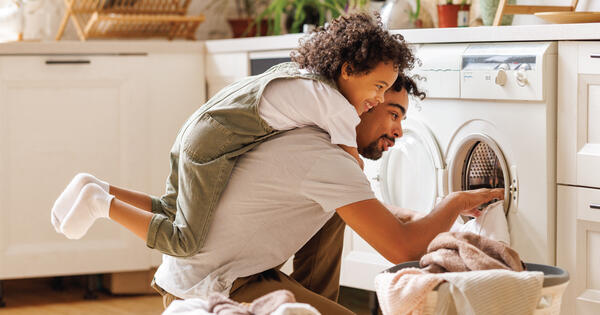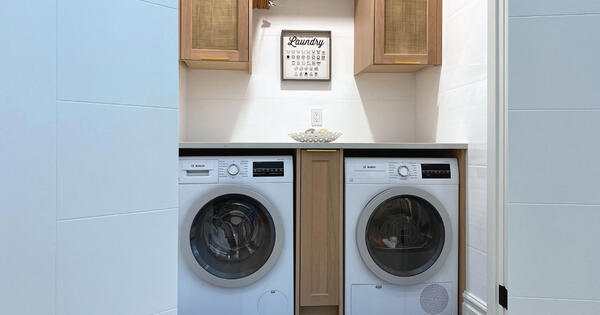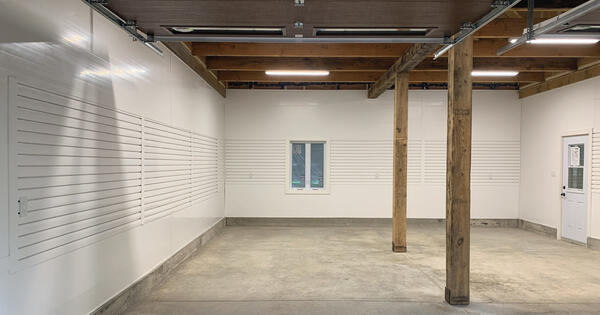Welcome to the heart of your home—the laundry room. Often overlooked but undeniably essential, an organized laundry room can make a world of difference.
In this blog post, we'll explore how well-designed laundry room shelves can elevate both the functionality and aesthetics of your space.



Assessing Your Laundry Room Storage Needs
When choosing shelf designs for your laundry room, it's important to consider various factors to ensure functionality, efficiency, and aesthetics. Here's a list of considerations to make before adding new shelves to your cart:
- Available Space: Measure the dimensions of your laundry room to determine the available wall space for shelves. Consider the height of the room to optimize vertical storage.
- Storage Needs: Assess the amount and types of items you need to store in the laundry room, such as detergent, fabric softener, cleaning supplies, laundry baskets, etc. Determine if you need space for hanging clothes, folding, or storing bulky items.
- Frequency of Use: If the laundry room is frequently used, prioritize easily accessible shelves for frequently used items. Consider open shelves for quick access or closed cabinets for a cleaner look.
- Ventilation: Ensure that the shelf design allows for proper ventilation, especially if you store items like cleaning supplies that may emit fumes.
- Laundry Room Layout: Take into account the location of appliances (washer, dryer) and how the shelves will complement the overall layout for convenient use.
- Material and Durability: Choose materials that can withstand the humidity and potential spills in a laundry room. Common options include moisture-resistant laminates, metal, or plastic. Ensure the chosen material is easy to clean and maintain.
- Aesthetics: Consider the visual appeal of the shelves and how they integrate with the overall design of the laundry room. Choose colors and finishes that complement the room's decor.
- Budget: Determine your budget for shelf materials and installation, keeping in mind that there are various options available at different price points.
- Accessibility: Ensure that the chosen shelf design allows for easy access to all items, avoiding the need to reach too high or too low.
- Utility and Multi-functionality: Explore shelves that may serve multiple purposes, such as a countertop for folding clothes or a pull-out ironing board.
Taking these factors into consideration will help you choose a shelf design that not only maximizes storage but also enhances the overall functionality and aesthetics of your laundry room.

Best Wall Material to Support On-the-Wall Laundry Room Shelves
Not all walls are created equal, and neither are the shelving systems they support. Whether it's drywall, pegboard, or slatwall, each material has its pros and cons.
1. Drywall
Drywall can serve as your laundry room’s primary wall material, but it may need additional support like wall anchors or brackets for shelves and is best suited for lightweight storage or decorative shelving.
Pros:
- Versatility: Drywall is a common building material, which means it’s readily available and you can mount most shelving types to it with the right fasteners in place.
- Cost-Effective: Drywall is generally less expensive than specialized storage systems, which makes it favorable for lower budget laundry room renovations.
- Smooth Finish: Provides a clean and finished look when painted.
Cons:
- Limited Strength: Drywall alone may not have sufficient strength to support heavy shelves without additional support.
- Limited Flexibility: If your storage needs change or you decide you don’t like a shelf’s placement, you’ll have to spend time and money on patching up holes in the wall.
- Vulnerability to Moisture: Drywall is susceptible to damage from moisture, which is common problem in laundry rooms.
2. Pegboard
Pegboards are a popular storage system and are ideal for organizing smaller items like cleaning supplies, tools, or accessories.
Pros:
- Customization: Pegboards allow for easy customization with hooks, pegs, and brackets to hang various items.
- Visibility: Items are easily visible and accessible.
- Design Flexibility: Pegboard is available in a variety of colors and can be painted relatively easily.
Cons:
- Weight Limitations: Pegboard often can’t support heavy items or bulky storage solutions like shelves.
- Durability: Pegboard is often made from medium-density fiberboard (MDF), which is an easy material to damage and any damage is permanent — since it's not made of solid wood, MDF can't be sanded to hide dents or scratches.
- Moisture Resistance: MDF pegboard has a water-resistant surface, but the interior wood fibers will swell and mold if exposed to moisture.
3. Slatwall
Slatwall systems like Trusscore SlatWall are excellent for creating a modular and organized storage space in your laundry room.
Pros:
- Versatility: Trusscore SlatWall can be installed as a track, section, or half wall, allowing you to turn as much or as little of your laundry room walls into storage space. It can also be installed with Trusscore Wall&CeilingBoard to create a full wall finish.
- Flexibility: Your organizational and storage needs will likely change over time, and you don’t want to be stuck with your original setup. Trusscore SlatWall shelves, hooks, and baskets, snap into place and can moved around or replaced whenever you’d like.
- High-Strength Storage: Trusscore SlatWall can support up to 75 pounds per square foot, which means you can store even your heaviest laundry room items on the wall.
- Moisture Resistance: Trusscore SlatWall is 100% moisture and water resistant and will never grow mold or mildew, making it perfectly suited to humid laundry rooms.
Cons:
- Cost: Slatwall systems can be more expensive than other options.
- Limited Colors: Trusscore SlatWall is only available in white and gray, which may be limiting if you want to create a colorful or maximalist laundry room.
Ultimately, the choice between drywall, pegboard, and slatwall systems depends on your specific needs, budget, and the items you plan to store in the laundry room. Drywall can be cost-effective but might require additional support for shelves. Pegboards are great for lightweight and easily accessible items. Slatwall systems offer versatility and strength, making them suitable for a more organized and customized laundry room.
Standard Laundry Room Shelving Options
Wall-mounted shelves, freestanding shelves, and floating shelves are standard options for laundry rooms. Here are the pros and cons of each, considering space and style.
1. Wall-Mounted Shelves
Wall-mounted shelves are ideal for small rooms or areas where floor space is limited and provide an opportunity for stylish displays or functional storage without occupying valuable floor space.
Pros:
- Space-Saving: Wall-mounted shelves maximize floor space and are ideal for smaller rooms.
- Versatility: They can be installed at any height, allowing for customization based on storage needs.
- Aesthetic Appeal: Wall-mounted shelves can enhance the visual appeal of a room and create a clean, organized look.
Cons:
- Installation: Requires drilling into the wall, which may not be suitable for all wall types or rental spaces.
- Weight Limit: The weight capacity is limited by the strength of the wall and the quality of installation.
2. Freestanding Shelves
Freestanding shelves are suitable for larger rooms with more floor space and offer flexibility in terms of rearrangement and styling options
Pros:
- Portability: Freestanding shelves can be moved and rearranged without the need for installation.
- No Wall Damage: Since they are not attached to the wall, there's no need for drilling or causing damage.
- Versatility: Available in various styles, sizes, and materials to suit different aesthetics.
Cons:
- Space Requirement: Takes up floor space, which may not be ideal for smaller rooms.
- Less Stability: May not be as stable as wall-mounted options, making them potentially less suitable for heavy items or in high-traffic areas.
3. Floating Shelves
Floating shelves provide an illusion of space due to their floating appearance and are well-suited for modern and minimalist interiors.
Pros:
- Modern Aesthetic: Floating shelves create a contemporary and sleek look.
- Easy to Clean: Since they are mounted without visible brackets, cleaning is straight forward.
- Versatility: Can be installed at various heights and in creative arrangements.
Cons:
- Weight Limit: Like wall-mounted shelves, floating shelves often have weight limitations.
- Installation Challenge: Requires careful measurement and installation to achieve a level and secure result.
The choice between wall-mounted shelves, freestanding shelves, and floating shelves depends on your specific needs, available space, and preferred style. Consider your storage requirements, the layout of the room, and your design preferences when selecting the most suitable shelving option.
Best Material for Laundry Room Shelves
Selecting the right materials for your shelves is essential for durability and style. From classic wood to modern metal and wire, each material contributes to the overall aesthetic. Here's an overview of different materials commonly used for shelves, along with their durability and considerations for finishes that complement your overall laundry room design.
1. Wood
Durability:
- Pros: Wood is a versatile and sturdy material, offering good durability.
- Cons: Wood is susceptible to moisture damage, especially in a laundry room where humidity levels may be higher.
Finish Considerations:
- Painted Wood: Offers a clean and customizable look, allowing you to match or contrast with the laundry room's color scheme.
- Stained Wood: Provides a more natural and warm appearance. Consider a water-resistant sealant for added protection against moisture.
2. Metal
Durability:
- Pros: Metal shelves, especially those made from stainless steel, are highly durable and resistant to moisture and rust.
- Cons: May be heavier and may require additional support for heavier loads.
Finish Considerations:
- Polished or Brushed Metal: Modern and sleek, it can complement a contemporary laundry room.
- Powder-Coated Finish: Adds color options while providing an extra layer of protection against corrosion.
3. Wire
Durability:
- Pros: Wire shelves are lightweight, resistant to moisture, and allow for good ventilation.
- Cons: May not be suitable for holding smaller items or items with a flat base.
Finish Considerations:
- Chrome or Stainless-Steel Finish: Provides a clean and modern look. Chrome offers a shinier appearance, while stainless steel is more matte
4. Glass
Durability:
- Pros: Tempered glass shelves are durable and resistant to moisture.
- Cons: Glass can be heavier, and it may show fingerprints or smudges.
Finish Considerations:
- Clear Glass:Creates an open and airy look, suitable for a modern and elegant laundry room.
- Frosted or Tinted Glass: Offers a more subtle appearance and can help conceal the contents of the shelves.
5. Plastic or Laminate
Durability:
- Pros: Lightweight, resistant to moisture, and affordable.
- Cons: ay not be as durable as some other materials, especially for heavy loads.
Finish Considerations:
- Colorful Laminates: Ideal for adding a pop of color to the laundry room. Consider high-pressure laminates for better durability.
6. Melamine
Durability:
- Pros: Melamine is a particleboard with a laminated surface, providing a smooth and durable finish.
- Cons: Vulnerable to moisture if the edges are not properly sealed.
Finish Considerations:
- Wood Grain or Solid Color Melamine: Mimics the look of wood but with enhanced resistance to moisture. Its ideal for a clean and contemporary laundry room.
Overall Material Considerations
The ideal material and finish for your laundry room shelves will depend on your preferences, the overall design of the space, and the specific requirements for durability and functionality:
- Choose a material and finish that complements the overall design and style of your laundry room.
- Given the nature of laundry rooms, prioritize materials that are resistant to moisture and humidity.
- Consider the ease of cleaning and maintenance when choosing finishes.
7 Shelves to Maximize Space in Small Laundry Rooms
If you have a small laundry room, there is also shelving that maximizes space:
- Wall-Mounted Shelves: Utilize vertical space with wall-mounted shelves above the washer and dryer. Install shelves at different heights to accommodate various items.
- Floating Shelves: Create a clean and open look with floating shelves that don't take up floor space. Install them above countertops or near the ceiling to maximize wall space.
- Fold-Out or Pull-Out Shelves: Opt for fold-out or pull-out shelves that can be hidden when not in use, providing flexibility in a small space. Consider fold-out ironing board shelves for a dual-purpose solution.
- Over-the-Door Shelving: Install over-the-door shelves on the back of the laundry room door to maximize unused space. Use these shelves for storing cleaning supplies, small laundry items, or even shoes.
- Corner Shelves: Install corner shelves to make use of often-overlooked space. Corner shelves can be open or enclosed, depending on your storage needs.
- Under-Shelf Baskets: Maximize shelf space by adding under-shelf baskets for storing small items or items with irregular shapes. These baskets can be easily attached to existing shelves.
- Slim Shelves Between Appliances: Take advantage of the narrow space between the washer and dryer with slim, vertical shelves for storing laundry essentials.
Remember to assess your specific storage needs and the layout of your small laundry room to determine the most effective combination of shelving ideas for your space.

Organizing Items on Your Laundry Room Shelves
Organizing items on shelves is key to maximizing the functionality of your laundry room. Here's a list of tips organized by different categories:
Organizing Laundry Supplies
A standard laundry room will store everything from detergent to ironing boards. To keep yours tidy, do the following:
- Categorize by Function: Group similar items together, such as detergents, fabric softeners, and stain removers, to make it easy to find what you need.
- Use Clear Containers: Store powdered detergents, pods, and laundry boosters in clear containers with labels for quick identification.
- Use Vertical Storage for Ironing Essentials: Install hooks or small shelves for hanging ironing boards, iron, and spray bottles vertically, saving floor and shelf space.
- Create a Laundry Basket Station: Designate a shelf for laundry baskets or hampers, making it easy to sort and store dirty clothes.
Organizing Cleaning Products
If you store your standard household cleaning products in your laundry room, keep these tips in mind:
- Categorize by Purpose: Arrange cleaning products in categories such as surface cleaners, glass cleaners, and disinfectants for quick access during cleaning tasks.
- Utilize Pull-Out Bins: Use pull-out bins or baskets for storing cleaning cloths, sponges, and brushes. These can be easily accessed and tucked away.
- Store Bulk Items Efficiently: If you buy cleaning supplies in bulk, transfer them to labeled, smaller containers to save space and make dispensing easier.
- Mount Brooms and Mops: Install hooks or clips on the wall to hang brooms, mops, and dusters, preventing clutter on the floor.
Storing Other Baskets and Bins
And for any other storage baskets or bins you keep in your laundry room, consider doing the following:
- Label Baskets Clearly: Label storage baskets or bins with categories like "lost socks," "pet supplies," or "miscellaneous" to maintain order.
- Use Pull-Out Baskets: Opt for pull-out baskets or bins on lower shelves for easy access to items stored towards the back.
- Color-Coded Baskets: Consider color-coded baskets for each family member's laundry or specific types of items, enhancing visual organization.
- Stackable Bins for Vertical Storage: Utilize stackable bins to create vertical storage for items like folded towels, linens, or bulk supplies.
Efficient organization not only enhances the functionality of your laundry room but also contributes to a visually appealing and stress-free space. Customize these tips based on your specific storage needs and the layout of your laundry room.






